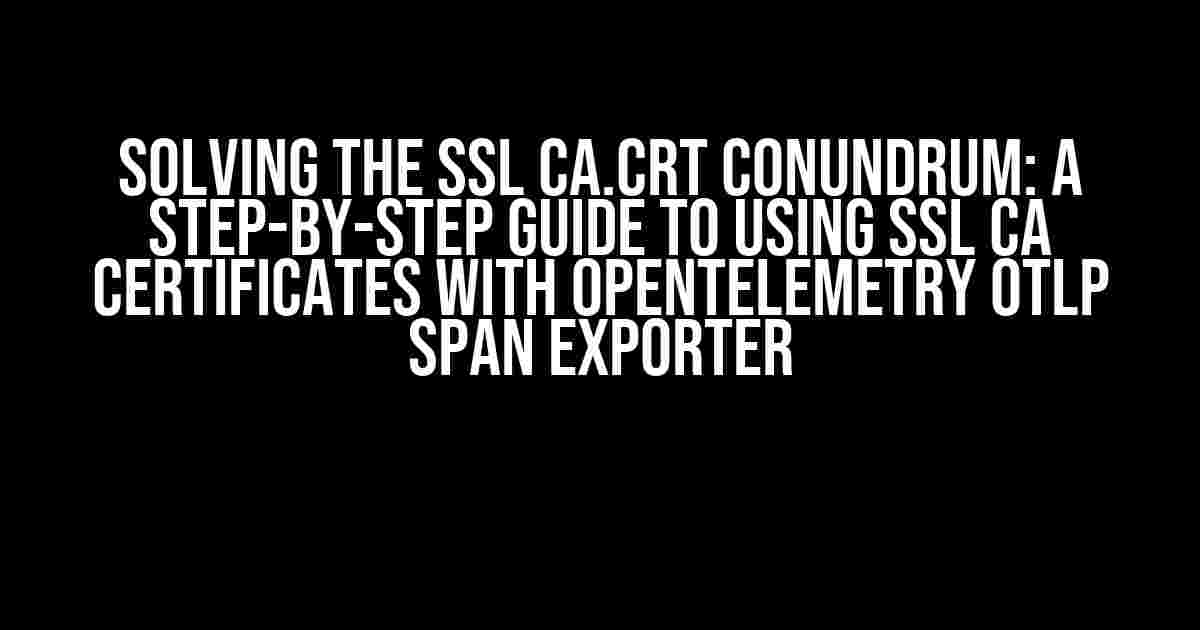Introduction
Are you struggling to use your SSL CA certificate with OpenTelemetry’s OTLP Span Exporter? You’re not alone! Many developers face this common challenge, but fear not, dear reader, for we’re about to embark on a troubleshooting adventure to get your SSL CA certificate working seamlessly with OTLP Span Exporter.
Understanding the Problem
Before we dive into the solution, let’s quickly understand the problem. When trying to use an SSL CA certificate with OTLP Span Exporter, you might encounter errors, such as ” unable to load CA certificate” or “invalid certificate”. This is often due to the way OTLP Span Exporter expects the certificate to be formatted or the lack of proper configuration.
What is OTLP Span Exporter?
OTLP Span Exporter is a part of OpenTelemetry, a popular open-source observability framework. It enables the export of telemetry data, such as traces, metrics, and logs, to various backends, including services like Zipkin, Jaeger, and New Relic. OTLP Span Exporter plays a crucial role in sending span data to these backends, but it requires proper configuration, including SSL certificates, to establish secure connections.
Step 1: Preparing Your SSL CA Certificate
To use an SSL CA certificate with OTLP Span Exporter, you’ll need to ensure it’s in the correct format. Here are the steps to prepare your certificate:
-
Obtain your SSL CA certificate in PEM format (usually with a .pem or .crt extension).
-
Verify the certificate is in the correct format by checking the header and footer. A valid PEM certificate should start with
-----BEGIN CERTIFICATE-----and end with-----END CERTIFICATE-----. -
If your certificate is in a different format, such as DER or PFX, convert it to PEM using tools like OpenSSL:
openssl x509 -inform der -in certificate.der -out certificate.pem
Step 2: Configuring OTLP Span Exporter
Now that your SSL CA certificate is ready, it’s time to configure OTLP Span Exporter to use it. You can do this through environment variables, configuration files, or programmatically, depending on your application and infrastructure.
Environment Variables
Set the following environment variables to configure OTLP Span Exporter:
-
OTEL_EXPORTER_OTLP_CERTFILE: path to your SSL CA certificate (e.g.,/path/to/ca.crt) -
OTEL_EXPORTER_OTLP_CERTKEYFILE: path to your private key (if applicable)
Configuration Files
Create a configuration file (e.g., otlp.yaml) with the following content:
exporters:
otlp:
certificate:
file: /path/to/ca.crt
private_key:
file: /path/to/private_key.pem
In your application, load this configuration file using the relevant OpenTelemetry SDK or API.
Programmatic Configuration
In your code, create an instance of the OTLP Span Exporter and set the certificate and private key programmatically:
import { OTLPExporter } from '@opentelemetry/exporter-otlp';
const exporter = new OTLPExporter({
url: 'https://your-backend.com',
certificate: fs.readFileSync('/path/to/ca.crt'),
privateKey: fs.readFileSync('/path/to/private_key.pem'),
});
Step 3: Verifying the Configuration
After configuring OTLP Span Exporter, verify that it’s using the SSL CA certificate correctly:
-
Check the OTLP Span Exporter logs for any certificate-related errors or warnings.
-
Use tools like OpenSSL to test the connection to your backend, ensuring the certificate is being presented correctly:
openssl s_client -connect your-backend.com:443 -CAfile /path/to/ca.crt
Troubleshooting Common Issues
If you’re still encountering issues, check the following common problems:
| Issue | Solution |
|---|---|
| Unable to load CA certificate | Verify the certificate is in the correct format (PEM) and the path is correct. |
| Invalid certificate | Check the certificate’s expiration date, ensure it’s trusted by the backend, and verify the private key matches the certificate. |
| Connection refused or timeout | Verify the backend is reachable, and the URL and port are correct. |
Conclusion
With these steps and troubleshooting tips, you should now be able to successfully use your SSL CA certificate with OpenTelemetry’s OTLP Span Exporter. Remember to verify your configuration, check for common issues, and test your connection to ensure secure and reliable telemetry data export.
If you’re still having trouble, don’t hesitate to reach out to the OpenTelemetry community or seek help from experts in the field.
Happy tracing!
Here are 5 Q&A about “Not able to use ssl ca.crt in opentelemetry OTLPSpanExporter” :
Frequently Asked Question
Having trouble configuring SSL/TLS certificates with OpenTelemetry’s OTLPSpanExporter? We’ve got you covered!
Why does OTLPSpanExporter fail to load the SSL/TLS certificate?
Make sure the certificate file is in PEM format and has the correct file path. Also, ensure that the file is not corrupted or empty. You can try opening the file in a text editor to verify its contents.
How do I specify the SSL/TLS certificate in the OTLPSpanExporter configuration?
You can specify the SSL/TLS certificate by setting the `tls_ca_cert_path` option in the OTLPSpanExporter configuration. For example: `otlpSpanExporter := otlptr.WithTLSConfig(otlptr.TLSConfig{CAFilePath: “path/to/ca.crt”})`.
What is the minimum required certificate information for OTLPSpanExporter to work?
The minimum required information is the CA certificate (ca.crt) file. However, you may also need to provide the client certificate (cert.crt) and private key (key.pem) files depending on your specific use case.
Why does OTLPSpanExporter still fail to connect to the OpenTelemetry collector even after specifying the correct SSL/TLS certificate?
Check the OpenTelemetry collector’s configuration to ensure it is configured to use the same SSL/TLS certificate. Also, verify that the collector is reachable and running. You can try using the `otel` command-line tool to test the connection.
Are there any additional security considerations when using SSL/TLS certificates with OTLPSpanExporter?
Yes, ensure that the certificate files are properly secured and not accessible to unauthorized users. Also, consider using secure protocols such as TLS 1.2 or higher, and rotates certificates regularly to maintain security.

